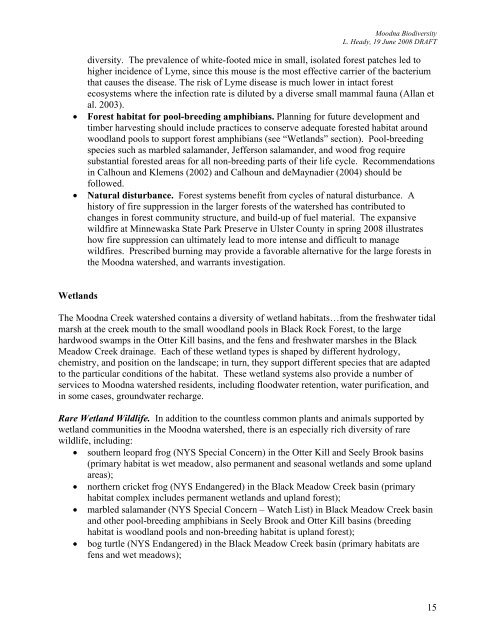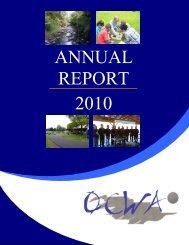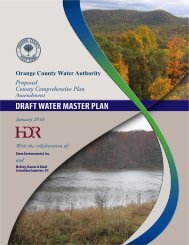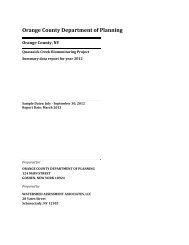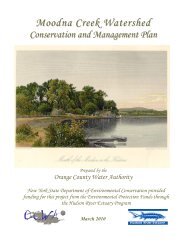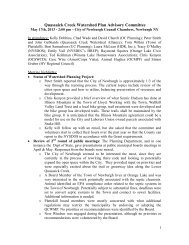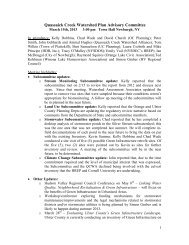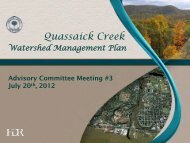Biodiversity of the Moodna Creek Watershed - Orange County Water ...
Biodiversity of the Moodna Creek Watershed - Orange County Water ...
Biodiversity of the Moodna Creek Watershed - Orange County Water ...
You also want an ePaper? Increase the reach of your titles
YUMPU automatically turns print PDFs into web optimized ePapers that Google loves.
<strong>Moodna</strong> <strong>Biodiversity</strong><br />
L. Heady, 19 June 2008 DRAFT<br />
diversity. The prevalence <strong>of</strong> white-footed mice in small, isolated forest patches led to<br />
higher incidence <strong>of</strong> Lyme, since this mouse is <strong>the</strong> most effective carrier <strong>of</strong> <strong>the</strong> bacterium<br />
that causes <strong>the</strong> disease. The risk <strong>of</strong> Lyme disease is much lower in intact forest<br />
ecosystems where <strong>the</strong> infection rate is diluted by a diverse small mammal fauna (Allan et<br />
al. 2003).<br />
• Forest habitat for pool-breeding amphibians. Planning for future development and<br />
timber harvesting should include practices to conserve adequate forested habitat around<br />
woodland pools to support forest amphibians (see “Wetlands” section). Pool-breeding<br />
species such as marbled salamander, Jefferson salamander, and wood frog require<br />
substantial forested areas for all non-breeding parts <strong>of</strong> <strong>the</strong>ir life cycle. Recommendations<br />
in Calhoun and Klemens (2002) and Calhoun and deMaynadier (2004) should be<br />
followed.<br />
• Natural disturbance. Forest systems benefit from cycles <strong>of</strong> natural disturbance. A<br />
history <strong>of</strong> fire suppression in <strong>the</strong> larger forests <strong>of</strong> <strong>the</strong> watershed has contributed to<br />
changes in forest community structure, and build-up <strong>of</strong> fuel material. The expansive<br />
wildfire at Minnewaska State Park Preserve in Ulster <strong>County</strong> in spring 2008 illustrates<br />
how fire suppression can ultimately lead to more intense and difficult to manage<br />
wildfires. Prescribed burning may provide a favorable alternative for <strong>the</strong> large forests in<br />
<strong>the</strong> <strong>Moodna</strong> watershed, and warrants investigation.<br />
Wetlands<br />
The <strong>Moodna</strong> <strong>Creek</strong> watershed contains a diversity <strong>of</strong> wetland habitats…from <strong>the</strong> freshwater tidal<br />
marsh at <strong>the</strong> creek mouth to <strong>the</strong> small woodland pools in Black Rock Forest, to <strong>the</strong> large<br />
hardwood swamps in <strong>the</strong> Otter Kill basins, and <strong>the</strong> fens and freshwater marshes in <strong>the</strong> Black<br />
Meadow <strong>Creek</strong> drainage. Each <strong>of</strong> <strong>the</strong>se wetland types is shaped by different hydrology,<br />
chemistry, and position on <strong>the</strong> landscape; in turn, <strong>the</strong>y support different species that are adapted<br />
to <strong>the</strong> particular conditions <strong>of</strong> <strong>the</strong> habitat. These wetland systems also provide a number <strong>of</strong><br />
services to <strong>Moodna</strong> watershed residents, including floodwater retention, water purification, and<br />
in some cases, groundwater recharge.<br />
Rare Wetland Wildlife. In addition to <strong>the</strong> countless common plants and animals supported by<br />
wetland communities in <strong>the</strong> <strong>Moodna</strong> watershed, <strong>the</strong>re is an especially rich diversity <strong>of</strong> rare<br />
wildlife, including:<br />
• sou<strong>the</strong>rn leopard frog (NYS Special Concern) in <strong>the</strong> Otter Kill and Seely Brook basins<br />
(primary habitat is wet meadow, also permanent and seasonal wetlands and some upland<br />
areas);<br />
• nor<strong>the</strong>rn cricket frog (NYS Endangered) in <strong>the</strong> Black Meadow <strong>Creek</strong> basin (primary<br />
habitat complex includes permanent wetlands and upland forest);<br />
• marbled salamander (NYS Special Concern – Watch List) in Black Meadow <strong>Creek</strong> basin<br />
and o<strong>the</strong>r pool-breeding amphibians in Seely Brook and Otter Kill basins (breeding<br />
habitat is woodland pools and non-breeding habitat is upland forest);<br />
• bog turtle (NYS Endangered) in <strong>the</strong> Black Meadow <strong>Creek</strong> basin (primary habitats are<br />
fens and wet meadows);<br />
15


